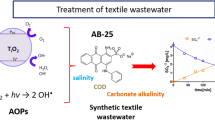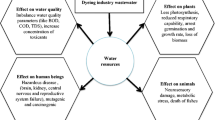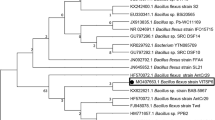Abstract
The factors affecting decolorization of anthraquinone dye represented by Reactive Blue 4 (RB4) and azo dye represented by Methyl Orange (MO) were studied in batch experiments under mesophilic (35 °C) and thermophilic (55 °C) anaerobic conditions. The results indicated differences in decolorization properties of the dyes with different chromophore structures. In abiotic conditions, MO could be decolorized by a physicochemical reaction when it was sterilized at 121 °C together with sludge cells or glucose. RB4 only showed absorption onto the cell mass. The presence of a redox mediator accelerated the decolorizing reaction when supplied together with glucose in the presence of sterilized sludge cells. In biotic conditions, the results indicated that the biological activity of microorganisms was an important factor in decolorization. The main factor involved in decolorization was the conversion of cosubstrate as electron donor, which reacted with dye as an electron acceptor in electron transfer. Redox mediators, anthraquinone-2-sulfonic acid, and anthraquinone could accelerate decolorization even if a small amount (0.2 mM) was applied. On the other hand, a high concentration of redox mediator (1.0 mM) had an inhibitory effect on decolorization especially under thermophilic conditions. In addition, the decolorization of dye was accelerated by increasing treatment temperature, as shown in biotic treatments. Based on these results, increasing the treatment temperature could be used to improve the decolorizing process of textile dye wastewater treatment, especially for recalcitrant dyes such as anthraquinone.









Similar content being viewed by others
References
McMullan, G., Meehan, C., Conneely, A., Kirby, N., Robison, T., Nigam, P., et al. (2001). Applied Microbiology and Biotechnology, 56, 81–87. doi:10.1007/s002530000587.
O’Neill, C., Hawkes, F. R., Hawkes, D. L., Lourenco, N. D., Pinheiro, H. M., & Delee, W. (1999). Journal of Chemical Technology and Biotechnology (Oxford, Oxfordshire: 1986), 74, 1009–1018. doi:10.1002/(SICI)1097-4660(199911)74:11<1009::AID-JCTB153>3.0.CO;2-N.
Gingell, R., & Walker, R. (1971). Xenobiotica, 1, 231–239.
Van der Zee, F. P., Bisschops, I. A. E., Blanchard, V. G., Bouwman, R. H. M., Lettinga, G., & Field, J. A. (2003). Water Research, 37, 3098–3109. doi:10.1016/S0043-1354(03)00166-0.
Kudlich, M., Keck, A., Klein, J., & Stolz, A. (1997). Applied and Environmental Microbiology, 63, 3691–3694.
Cervantes, F. J., Van der Zee, F. P., Lettinga, G., & Field, J. A. (2001). Water Science and Technology, 44, 123–128.
Dos Santos, A. B., Cervantes, F. J., Yaya-Beas, R. E., & Van Lier, J. B. (2003). Enzyme and Microbial Technology, 33, 942–951. doi:10.1016/j.enzmictec.2003.07.007.
Van der Zee, F. P., Lettinga, G., & Field, J. A. (2000). Water Science and Technology, 42, 301–308.
Field, J. A., Cervantes, F. J., van der Zee, F. P., & Lettinga, G. (2000). Water Science and Technology, 42, 215–222.
Dos Santos, A. B., Bisschops, I. A. E., Cervantes, F. J., & van Lier, J. B. (2004). Chemosphere, 55, 1149–1157. doi:10.1016/j.chemosphere.2004.01.031.
Kashefi, K., Tor, J. T. M., Holmes, D. E., van Praagh, C. V. G., Reysenbach, A. L., & Lovley, D. R. (2002). International Journal of Systematic and Evolutionary Microbiology, 52, 719–728. doi:10.1099/ijs.0.01953-0.
Acknowledgement
This study was carried out under the JSPS-NRCT Scientific Cooperation Program and was financially supported by a Japanese government scholarship (MOMBUKAGAKUSHO: MEXT).
Author information
Authors and Affiliations
Corresponding author
Rights and permissions
About this article
Cite this article
Boonyakamol, A., Imai, T., Chairattanamanokorn, P. et al. Key Factors Regarding Decolorization of Synthetic Anthraquinone and Azo Dyes. Appl Biochem Biotechnol 158, 180–191 (2009). https://doi.org/10.1007/s12010-008-8330-0
Received:
Accepted:
Published:
Issue Date:
DOI: https://doi.org/10.1007/s12010-008-8330-0




